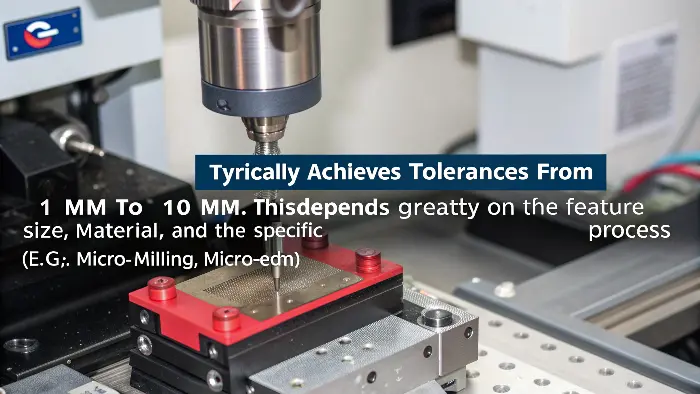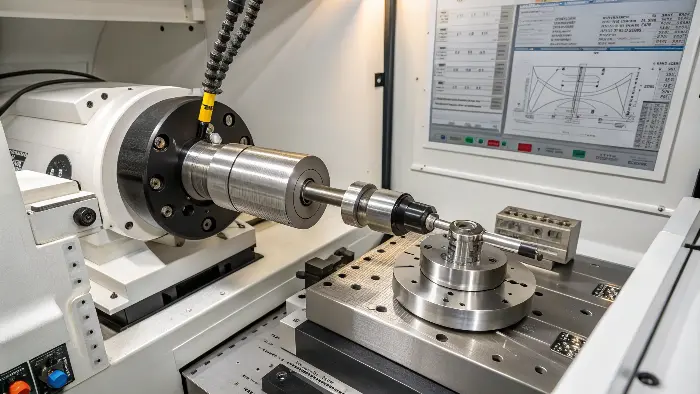Struggling to get parts within those ultra-tight specs? Wondering if micron precision is truly achievable? It demands more than just a good machine; it’s a total system approach.
Yes, achieving micron-level tolerances (e.g., ±0.001mm to ±0.005mm) in CNC machining is possible. It requires high-precision machines, optimal cutting tools, strict environmental controls, advanced programming, meticulous setup, and sophisticated metrology. Consistent results are challenging but attainable.
I talk to engineers like Alex all the time. They are designing incredible things, often needing parts with tolerances that leave no room for error – we are talking microns. Achieving this level of precision is not a walk in the park. It is a combination of the right equipment, deep process knowledge, and an almost obsessive attention to detail. At QuickCNCs, we have invested heavily in understanding and implementing what it takes. It is not just about having a machine that claims micron capability; it is about the entire ecosystem around that machine.
What Are the Tolerances for CNC Machining, Generally Speaking?
Unsure about typical CNC precision? Specifying tolerances too tight or too loose can cause problems. Understanding standard ranges helps manage expectations and costs effectively.
General CNC machining tolerances typically range from ±0.005 inches (±0.127mm) for standard work to ±0.001 inches (±0.025mm) for precision work. Tighter tolerances are possible but increase complexity and cost.
When we talk about general CNC machining, the "standard" tolerance really depends on the shop, the machine, and the material. For many general engineering applications, a tolerance of around ±0.1mm (or ±0.004 inches) is quite common and achievable without extraordinary effort. I often see drawings with this as a default. If a part needs a bit more precision, say for fitting components, we might aim for ±0.05mm (±0.002 inches). Achieving this consistently requires well-maintained machines, good quality tooling, and skilled operators.
Several factors influence these general tolerances:
- Machine Quality and Condition: An older, less rigid machine will struggle more than a new, high-precision model.
- Material Stability: Some materials, like certain plastics or softer aluminum alloys, can warp or move during machining, affecting final tolerances.
- Tooling: Sharp, high-quality tools appropriate for the material are essential. Tool wear also plays a significant role.
- Workholding: The part must be held securely and repeatably.
- Cutting Strategy: Speeds, feeds, and depth of cut all influence the outcome.
For Alex’s typical robotic components, he might specify ±0.025mm (±0.001 inches) on critical features, which is already in the realm of precision machining, not just "general" work.So, What is the Micron Tolerance of a CNC Machine Itself?
Is your machine’s spec sheet the whole story? Confusing machine accuracy with achievable part tolerance can lead to disappointment. The machine’s capability is a foundation, not the final word.
A CNC machine’s micron tolerance refers to its inherent accuracy and repeatability, often stated as a few microns (e.g., 1-5 µm) by manufacturers. However, achieving this on an actual part involves many other factors.

CNC machine manufacturers often list impressive specifications for their equipment, sometimes mentioning accuracy or repeatability in the single-digit micron range. For example, a high-end machining center might boast a positioning accuracy of ±2 µm and a repeatability of ±1 µm. These numbers are important. They tell us about the machine’s potential, its mechanical precision, and the quality of its control systems (like linear scales and encoders). I always review these specs carefully when considering new equipment for QuickCNCs.
However, it is crucial to understand that the machine’s stated tolerance is not the same as the tolerance you will automatically get on every part you make. The machine’s precision is a component of the overall tolerance stack-up. Other factors include: - Thermal Stability: Machines heat up during operation. This thermal expansion in the machine structure, spindle, and even the workpiece can introduce errors measured in microns. Advanced machines have thermal compensation systems.
- Spindle Quality: Spindle runout (how true the tool rotates) directly impacts feature accuracy and surface finish.
- Axis Drives and Guideways: The precision and rigidity of how the machine axes move are fundamental.
- Control System Resolution: The smallest increment the machine can be commanded to move.
For Alex’s needs, knowing that the machine can position repeatably to a few microns is a good starting point. But then we have to build the rest of the process around that capability to actually machine a part to, say, 10 microns (±0.01mm).When We Talk About Micro Machining, What Tolerances Are Expected?
Dealing with tiny features? Realizing standard tolerances do not apply at the micro scale? Micro-machining requires specialized approaches to achieve its specific, tight tolerances.
Micro-machining typically achieves tolerances from ±1 µm to ±10 µm. This depends greatly on the feature size, material, and the specific micro-machining process (e.g., micro-milling, micro-EDM).

Micro-machining is a specialized field within CNC machining. It focuses on creating very small features, often with dimensions in the micron range, or on parts that are themselves very small. When I first encountered micro-machining projects, it was clear that the rules change a bit. The tools are incredibly tiny – sometimes thinner than a human hair. Spindle speeds can be extremely high, well over 100,000 RPM, to get appropriate cutting speeds with such small diameter tools.
The tolerances in micro-machining are often discussed relative to the feature size. Holding a ±5 µm tolerance on a 50 µm wide channel is a significant achievement.
Key considerations for micro-machining tolerances include: - Tool Deflection and Breakage: Tiny tools are fragile and can deflect easily.
- Material Grain Size: At the micro-scale, the material’s grain structure can influence cutting.
- Workpiece Clamping: Holding tiny parts securely without distortion is a challenge.
- Deburring: Removing burrs from micro-features often requires specialized techniques like laser deburring or abrasive flow machining.
- Metrology: Measuring features this small requires advanced tools like optical microscopes or scanning electron microscopes (SEMs).
Alex might encounter micro-machining if his robotic systems need miniature sensors, actuators, or optical fiber alignment components. The tolerances here are not just about overall part size, but the precision of these minute features.Ultimately, What Is the Smallest Machining Tolerance Possible with CNC?
Pushing the boundaries of precision? Wondering if sub-micron is a dream or reality? The smallest CNC tolerances demand extreme measures and are reserved for specialized applications.
The smallest CNC machining tolerances can reach sub-micron levels (less than ±1 µm). This is typically achieved using ultra-precision machines like diamond turning lathes, in highly controlled environments, for specific materials like optics or high-performance bearings.

This is the question that really gets to the cutting edge of manufacturing. Can we machine parts to tolerances below one micron? The answer is yes, but it is not your everyday CNC machining. This is the realm of ultra-precision machining, often involving specialized techniques like single-point diamond turning (SPDT). I have seen this used for making molds for optical lenses or components for scientific instruments.
Achieving sub-micron tolerances requires an almost fanatical dedication to controlling every variable: - Ultra-Precision Machines: These machines are built on granite bases for stability, have air bearings for frictionless movement, and active damping systems to eliminate vibration.
- Environmental Control: Temperature must be controlled to fractions of a degree Celsius. Air quality (cleanliness) is also critical.
- Tooling: Diamond tools are often used due to their extreme sharpness and wear resistance.
- Material Science: The workpiece material itself must be homogenous and stable.
- Process Control: Every step, from programming to final cleaning, is meticulously planned and executed.
- Metrology: Measuring at this level often requires interferometry or atomic force microscopy.
For Alex, even his tightest tolerance of ±0.01mm (10 microns) is considered very precise. Going from 10 microns down to 1 micron, or even sub-micron, represents an exponential increase in difficulty, cost, and time. It is usually reserved for applications where absolutely nothing else will do. While QuickCNCs focuses on high-precision machining, achieving consistent sub-micron tolerances is a highly specialized niche that we approach with partners when needed.Conclusion
Achieving micron-level tolerances is a complex interplay of machine capability, process control, environment, tooling, and expertise. It’s demanding but possible with the right approach and investment.


